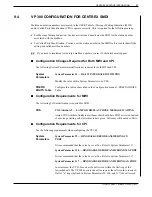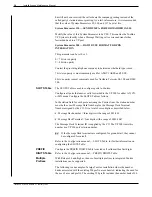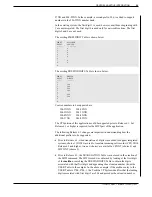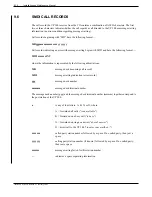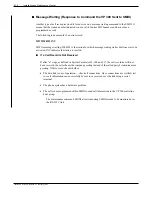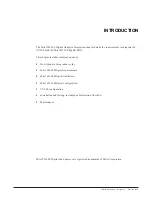
SMDI CALL RECORDS
The call record the VP 300 receives from the CO contains a combination of ASCII characters. The first
two or three characters indicate whether the call regards a call directed to the VP 300 or message waiting
information (an error condition regarding message waiting).
Call records beginning with “MD” have the following format —
MDgggmmmmaxxxxxxx yyyyyyy
Call records indicating an error with message waiting begin with MWI and have the following format —
MWI zzzzzzz INV
where the information is represented by the following abbreviations:
MD
message desk (incoming call record)
MWI
message waiting indication (error record)
ggg
message desk number
mmmm
message desk terminal number
The message desk number (ggg) and the message desk terminal number (mmmm) together correspond to
the port station of the VP 300.
a
is any of four letters: A, B, N, or D, where:
A = forwarded all calls (“is unavailable”)
B = forwarded on a busy call (“is busy”)
N = forwarded on ring no answer (“doesn't answer”)
D = direct call to the VP 300 (“to enter your mailbox...”)
xxxxxxx
called party station number followed by a space. If no called party, then just a
space.
yyyyyyy
calling party station number (if known) followed by a space. If no called party,
then just a space.
zzzzzzz
message waiting failed for this station number
—
indicates a space separating information
Toshiba VP Systems Release 6.1 February, 1993
9-14
Installation and Maintenance Manual
9.6
Summary of Contents for VP 300
Page 2: ......
Page 10: ......
Page 14: ......
Page 20: ...Toshiba VP Systems Release 7 1 July 1994 ...
Page 52: ...Toshiba VP Systems Release 6 1 February 1993 2 14 Installation and Maintenance Manual ...
Page 56: ...Toshiba VP Systems Release 7 1 July 1994 ...
Page 146: ......
Page 312: ...Toshiba VP Systems Release 7 1 July 1994 ...
Page 314: ......
Page 444: ......
Page 496: ......
Page 542: ......
Page 598: ...Toshiba VP Systems Release 6 1 February 1993 ...
Page 600: ...Toshiba VP Systems Release 6 1 February 1993 ...








